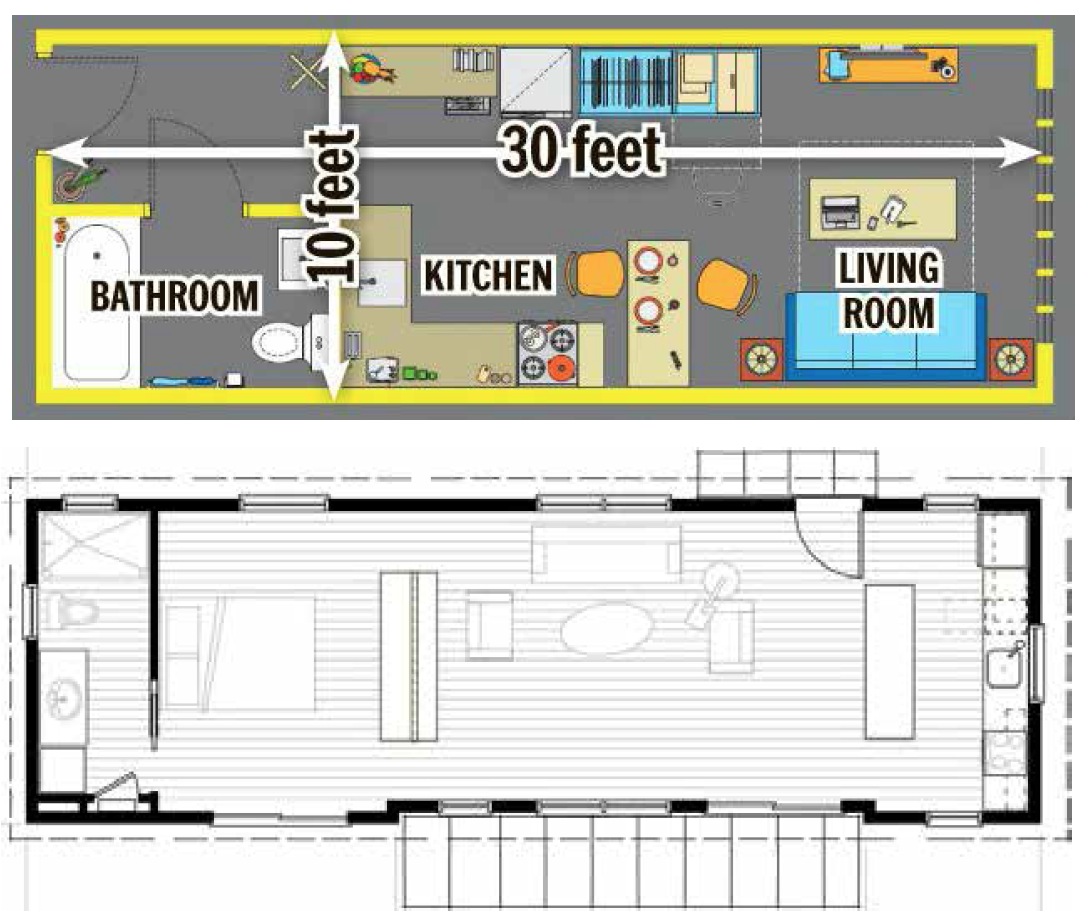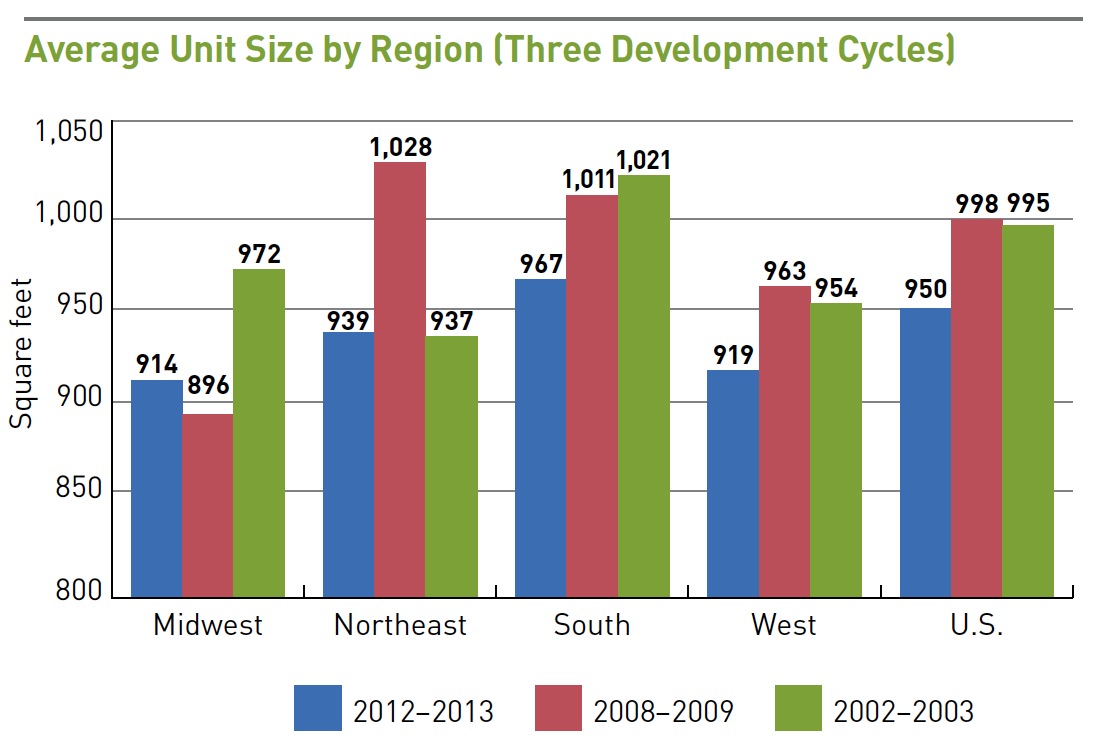URBAN LAND INSTITUTE
 A common perception exists that unit sizes in new apartments have been shrinking as developers seek higher density and higher revenue per square foot to offset rising land value and construction costs and to hold monthly rent at an affordable level relative to income. The ultimate incarnation of this trend has been the introduction—or the reintroduction—of very small units, often referred to as micro units. These very small (by traditional standards) apartments, leasing at approximately 20 percent to 30 percent lower monthly rent than conventional units, yet at very high value ratios (rent per square foot), have been offered or are being considered in urban and urbanizing locales, particularly high-density, expensive metropolitan markets such as Boston, New York, San Francisco, Seattle, and Washington, D.C. This research report explores this renewed trend in the United States and seeks to answer the following key questions:
A common perception exists that unit sizes in new apartments have been shrinking as developers seek higher density and higher revenue per square foot to offset rising land value and construction costs and to hold monthly rent at an affordable level relative to income. The ultimate incarnation of this trend has been the introduction—or the reintroduction—of very small units, often referred to as micro units. These very small (by traditional standards) apartments, leasing at approximately 20 percent to 30 percent lower monthly rent than conventional units, yet at very high value ratios (rent per square foot), have been offered or are being considered in urban and urbanizing locales, particularly high-density, expensive metropolitan markets such as Boston, New York, San Francisco, Seattle, and Washington, D.C. This research report explores this renewed trend in the United States and seeks to answer the following key questions:
- What exactly is a micro unit?
- How have smaller and micro-unit rental apartments performed in the marketplace compared
- with larger, more conventional apartments?
- Does the higher per square foot rent justify the higher construction cost?
- What are some of the examples across the country where micro units have been successfully developed and operated?
- What are the critical success factors and lessons learned from developers, owners, operators, and design professionals that have experience with this new breed of micro-unit community?
- What has been the experience of residents who have actually lived in one of these tiny apartments, what do they like and dislike, and what motivated them to consider a micro unit in the first place?
- What would motivate potential renters of conventional apartments to live in a smaller unit? Based on a compilation of all of the above, what is the likely future for micro units; is this a passing fad or a growing trend?
To answer these and other questions, the research team for this report analyzed hard data to understand the performance of smaller and micro units in the marketplace. The team also conducted consumer research with residents of micro units to understand their experience and satisfaction levels compared with occupants of conventional units. Finally, the team compiled case studies of micro-unit rental apartment communities and conducted a series of interviews with industry experts to identify best practices and lessons learned. The ultimate objective of this research is to gather and share innovative ideas that can contribute to the successful development of micro-unit communities in the future.
Some of the key findings, which the report provides in greater detail, follow:
- Although micro unit has no standard definition, a working definition is a small studio apartment, typically less than 350 square feet, with a fully functioning and accessibility compliant kitchen and bathroom. Under this definition, a 160-square-foot single-room-occupancy (SRO) unit that relies upon communal kitchen or bathroom facilities does not qualify as a true micro unit.
- Smaller and micro units outperform conventional units in the marketplace—they achieve higher occupancy rates and garner significant rental-rate premiums (rent per square foot) compared with conventional units. However, the stock of very small units is still quite limited, and it is difficult to know whether the performance of these smaller units is driven by their relative scarcity or whether significant pent-up demand for micro units actually exists.
- Both the consumer research and the case studies indicate that a segment of renters is indeed interested in the micro-unit concept; nearly a quarter of renters in conventional apartments indicate they would be interested or very interested in renting a micro unit. Depending upon one’s perspective, either this speaks to a potentially huge untapped market, or it remains a niche market.
- The appeal of micro units is largely about economics, but place and privacy are all part of the equation. Most respondents interested in micro units are willing to consider them in exchange for a lower monthly rent (approximately 20 percent to 30 percent below that of a conventionally sized unit), a highly desirable (typically authentic, urban/urbanizing, walkable, trendy) location, and the ability to live alone.
- The target market profile for micro units is predominantly young professional singles, typically under 30 years of age, with most under 27 years of age, trending slightly more male than female. Secondary segments include some couples and roommates, some older move-down singles, and pied-à-terre users.
- Developing and operating a rental apartment community with micro units are more expensive, but the premium rent per square foot achieved more than makes up for the added cost.
- Developers and design professionals have come up with a number of creative solutions that ensure micro units are compliant with Fair Housing Amendment Act and accessibility requirements, livable, and actually feel larger than they really are. Such items include flexible furniture systems, high ceilings (more than nine feet), oversized windows, built-in storage, gadget walls, and movable kitchen islands.
- Rental apartment communities with micro units also emphasize what is outside the confines of the unit itself. Developers tend to offer an extensive array of amenities, intimate gathering spaces, and services to residents that enable them to experience community outside their micro unit.
- A definite shift has taken place toward a greater mix of smaller studio and one-bedroom apartments, and micro units are a growing trend across the country with a number of communities under construction and many more in the planning stages. However, to hedge their bets, some savvy developers are building in the flexibility to convert side-by-side micro units back into conventional one- and two-bedroom units, just in case the concept is a flash in the pan.
Download full version (PDF): The Macro View on Micro Units
About the Urban Land Institute
uli.org
ULI, the Urban Land Institute, is a 501(c) (3) nonprofit research and education organization supported by its members.
Founded in 1936, we now have more than 33,000 members worldwide, representing the entire spectrum of land use and real estate development disciplines working in private enterprise and public service.
A multidisciplinary real estate forum, ULI facilitates an open exchange of ideas, information, and experience among industry leaders and policy makers dedicated to creating better places.
Tags: Housing, Micro Units, ULI, Urban land Institute







 RSS Feed
RSS Feed